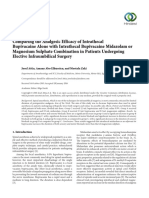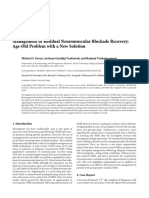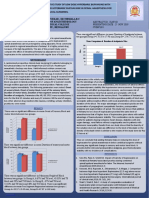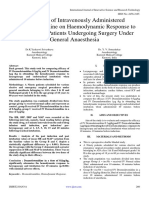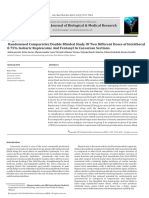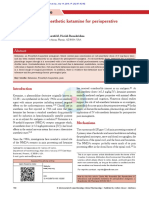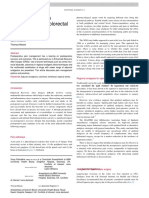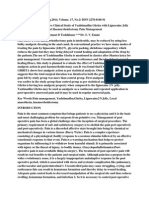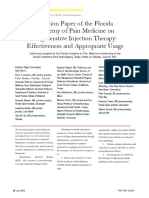Professional Documents
Culture Documents
Assessment of Efficacy of Midazolam As An Adjuvant To Intrathecal Bupivacaine For Lower Abdominal Surgeries
Original Title
Copyright
Available Formats
Share this document
Did you find this document useful?
Is this content inappropriate?
Report this DocumentCopyright:
Available Formats
Assessment of Efficacy of Midazolam As An Adjuvant To Intrathecal Bupivacaine For Lower Abdominal Surgeries
Copyright:
Available Formats
Volume 8, Issue 2, February – 2023 International Journal of Innovative Science and Research Technology
ISSN No:-2456-2165
Assessment of Efficacy of Midazolam as an
Adjuvant to Intrathecal Bupivacaine for Lower
Abdominal Surgeries
Dr. Kottam Surekha. Post Graduate, Dr. Shaik Mohammed Ghiyazuddin, Assistant professor,
Department of Anesthesiology, Kurnool Medical College Department of Anesthesiology, Kurnool medical college
Kurnool, Andhra Pradesh. Kurnool, Andhra Pradesh.
I. INTRODUCTION
Spinal anaesthesia is the most commonly used regional
anaesthetic technique. Local anaesthetic agents used for this
purpose provide good intraoperative analgesia. However,
they provide a very limited postoperative duration of action.
In order to overcome this problem and to maximise the
duration of anaesthesia-analgesia, many adjuvants, such as
intrathecal opioids and non-opioids, have increasingly been
tried in the last two decades to relieve postoperative pain.
Aims & Objectives
Bupivacaine when used alone produces analgesia for
2.5 to 3 hours, making it unsuitable in cases where the
duration of surgery is longer and in cases which require
further analgesia during post-operative period. Present study
is intended to evaluate the effect of addition of intrathecal
midazolam to bupivacaine to prolong the post-operative
analgesia.
II. METHODOLOGY Fig 2 Summary Results
A prospective randomized double-blind study was Both groups did not differ significantly as regard to
carried out on 60 adult ASA gr 1 and 2 pts, to compare the time of onset of sensory block, duration of action, time for
efficacy of intrathecal bupivacaine with midazolam and regression of sensory block to T12. There was significant
bupivacaine alone for post operative pain relief. Pts were duration of post operative analgesia observed in group BM.
randomly divided into 2 groups. Group B {n=30} received There were no episodes of bradycardia, hypotension,
3ml of 0.5% bupivacaine with 0.2 ml of 0.9% normal saline. sedation, intraoperatively or postoperatively and no
Group BM{n=30} received 3ml of 0.5% bupivacaine with vomiting, pruritis and urinary retention in post operative
0.2 ml of preservative free midazolam. period.
III. DISCUSSION
Our study shows that the addition of midazolam to
intrathecal bupivacaine significantly prolongs the duration
of postoperative analgesia. The time to first rescue analgesic
was more than 16 hrs in BM group as compared to 3.5 hrs in
B group. Antinociceptive action are mediated via
BZD/GABA-A receptor complex which are present in
lamina 2 of dorsal horn ganglia of spinal cord Intrathecal
midazolam probably causes release of an endogenous opioid
acting at spinal delta receptors as naltrindole. Intrathecal
midazolam besides causing analgesia has also been found to
be effective in suppressing reflex response to visceral
distention and its pain. Intrathecal midazolam has been
shown to be free of any neurotoxicity and other side effects
Fig 1 Demographic Profile Chart with dose up to 2mg.
IJISRT23FEB379 www.ijisrt.com 586
Volume 8, Issue 2, February – 2023 International Journal of Innovative Science and Research Technology
ISSN No:-2456-2165
IV. CONCLUSION
Intrathecal midazolam added to bupivacaine prolongs
duration of post op analgesia without prolonging the
duration of dermatomal sensory block with no side effects.
REFERENCES
[1]. Valentine MJ, lyons G bellemy MC.the effect of
intrathecal midazolam on post op pain. j of
anaesthesia 1996 13:589-593.
[2]. Edwards m, Serrao. mechanism by which midazolam
causes spinally mediated analgesia. anaesthesiology
1990-73,273,77.
[3]. Indian j, anaesthesia 2005; 49(1);37-39 effect of
intrathecal midazolam bupivacaine combination on
post op analgesia.
IJISRT23FEB379 www.ijisrt.com 587
You might also like
- Journal Homepage: - : IntroductionDocument8 pagesJournal Homepage: - : IntroductionIJAR JOURNALNo ratings yet
- A Comparative Study of Intrathecal Plain Bupivacaine Versus Bupivacaine With Midazolam For Subarachnoid Block in Lower Abdominal and Lower Limb SurgeriesDocument4 pagesA Comparative Study of Intrathecal Plain Bupivacaine Versus Bupivacaine With Midazolam For Subarachnoid Block in Lower Abdominal and Lower Limb SurgeriesInternational Journal of Innovative Science and Research TechnologyNo ratings yet
- Effect of Dexamethasone on Onset and Duration of Epidural Sensory BlockadeDocument8 pagesEffect of Dexamethasone on Onset and Duration of Epidural Sensory BlockadewikaNo ratings yet
- Scalp Block For Awake Craniotomy Lidocaine-BupivacDocument10 pagesScalp Block For Awake Craniotomy Lidocaine-BupivacremediNo ratings yet
- Journal Homepage: - : IntroductionDocument4 pagesJournal Homepage: - : IntroductionIJAR JOURNALNo ratings yet
- A Comparative Study of Intrathecal Injection of Bupivacaine Alone or With Fentanyl, Clonidine, and Neostigmine in Lower Abdominal SurgeriesDocument16 pagesA Comparative Study of Intrathecal Injection of Bupivacaine Alone or With Fentanyl, Clonidine, and Neostigmine in Lower Abdominal SurgeriesdhiyaNo ratings yet
- Clinical StudyDocument7 pagesClinical StudymeldaerNo ratings yet
- Journal Homepage: - : IntroductionDocument10 pagesJournal Homepage: - : IntroductionIJAR JOURNALNo ratings yet
- Does Intravenous Low Dose Dexmedetomidine Supplementation Has Beneficial Effects On Spinal Anaesthesia?Document4 pagesDoes Intravenous Low Dose Dexmedetomidine Supplementation Has Beneficial Effects On Spinal Anaesthesia?MOHAMMED IQBALNo ratings yet
- Efficacy of Dexamethasone As An Adjuvant To Bupivacaine in Caudal Anaesthesia For Lower Abdominal Surgeries in ChildrenDocument6 pagesEfficacy of Dexamethasone As An Adjuvant To Bupivacaine in Caudal Anaesthesia For Lower Abdominal Surgeries in ChildrenInternational Journal of Innovative Science and Research TechnologyNo ratings yet
- Effects of Intravenous Dexmedetomidine On Hyperbaric Bupivacaine Spinal Anesthesia: A Randomized StudyDocument8 pagesEffects of Intravenous Dexmedetomidine On Hyperbaric Bupivacaine Spinal Anesthesia: A Randomized StudyMOHAMMED IQBALNo ratings yet
- E044168 FullDocument7 pagesE044168 FulldrmelinjoeNo ratings yet
- Comparison of Bupivacaine-Dexmedetomidine VS Bupivacaine-Fentanyl VS Bupivacaine - Saline For Unilateral Spinal Anaesthesia in Lower Limb SurgeryDocument9 pagesComparison of Bupivacaine-Dexmedetomidine VS Bupivacaine-Fentanyl VS Bupivacaine - Saline For Unilateral Spinal Anaesthesia in Lower Limb SurgeryIJAR JOURNALNo ratings yet
- Effect of Supplementation of Low Dose Intravenous Dexmedetomidine On Characteristics of Spinal Anaesthesia With Hyperbaric BupivacaineDocument5 pagesEffect of Supplementation of Low Dose Intravenous Dexmedetomidine On Characteristics of Spinal Anaesthesia With Hyperbaric BupivacaineMOHAMMED IQBALNo ratings yet
- IJISRT23JUN363Document7 pagesIJISRT23JUN363International Journal of Innovative Science and Research TechnologyNo ratings yet
- The Effectiveness of Magnesium Sulphate Intravenous Bolus or Added As An Adjunct To Ropivacaine For Brachial Plexus Block in Upper Limb Orthopaedic SurgeriesDocument7 pagesThe Effectiveness of Magnesium Sulphate Intravenous Bolus or Added As An Adjunct To Ropivacaine For Brachial Plexus Block in Upper Limb Orthopaedic SurgeriesInternational Journal of Innovative Science and Research TechnologyNo ratings yet
- Comparison of Intravenous Magnesium Sulphate WithDocument8 pagesComparison of Intravenous Magnesium Sulphate Withshelly ranaNo ratings yet
- Segmental Spinal Anesthesia A Systematic ReviewDocument6 pagesSegmental Spinal Anesthesia A Systematic Reviewجعفر محمدNo ratings yet
- Keywords:-: Ibuprofen, Ketorolac, Nsaid, Vas, Preemptive AnalgesiaDocument8 pagesKeywords:-: Ibuprofen, Ketorolac, Nsaid, Vas, Preemptive AnalgesiaAnonymous izrFWiQNo ratings yet
- Buvanendran2009 PDFDocument6 pagesBuvanendran2009 PDFnadaNo ratings yet
- Jurnal RadaDocument3 pagesJurnal RadaMuh Ridho AkbarNo ratings yet
- 3 PBDocument7 pages3 PBDinda ArmeliaNo ratings yet
- Case Report: Management of Residual Neuromuscular Blockade Recovery: Age-Old Problem With A New SolutionDocument4 pagesCase Report: Management of Residual Neuromuscular Blockade Recovery: Age-Old Problem With A New SolutionFendy PrasetyoNo ratings yet
- Buharan MDDocument7 pagesBuharan MDNeha MasarkarNo ratings yet
- Does Bilateral Superficial Cervical Plexus Block.35Document3 pagesDoes Bilateral Superficial Cervical Plexus Block.35Fouad SolimanNo ratings yet
- Perbandingan Efek Penambahan Neostigmin 50 Μg Dan 75 Μg Pada Bupivakain Hiperbarik 0,5% 15 Mg Terhadap Lama Kerja Blokade Sensorik Dan Efek Samping Mual Muntah Pasca Operasi Anestesi SpinalDocument11 pagesPerbandingan Efek Penambahan Neostigmin 50 Μg Dan 75 Μg Pada Bupivakain Hiperbarik 0,5% 15 Mg Terhadap Lama Kerja Blokade Sensorik Dan Efek Samping Mual Muntah Pasca Operasi Anestesi SpinalsukrangNo ratings yet
- Intravenous Sub-Anesthetic Ketamine For Perioperative AnalgesiaDocument8 pagesIntravenous Sub-Anesthetic Ketamine For Perioperative AnalgesiaTommy ArisandyNo ratings yet
- Comparison of Postoperative Analgesic Effects of Epidural Ropivacaine With Butorphanol Versus Epidural Ropivacaine With Morphine in Patients Undergoing Below Umblical SurgeriesDocument5 pagesComparison of Postoperative Analgesic Effects of Epidural Ropivacaine With Butorphanol Versus Epidural Ropivacaine With Morphine in Patients Undergoing Below Umblical SurgeriesInternational Journal of Innovative Science and Research TechnologyNo ratings yet
- A Comparative Study of Low Dose Hyperbaric Bupivacine With Fentanyl and Hyperbaric Bupivacaine in Spinal Anaesthesia For Below Umbilical SurgeriesDocument1 pageA Comparative Study of Low Dose Hyperbaric Bupivacine With Fentanyl and Hyperbaric Bupivacaine in Spinal Anaesthesia For Below Umbilical SurgeriesTahirNo ratings yet
- RaVoR™ - Bipolar Radiofrequency Volume Reduction (RaVoR™) of The Inferior Turbinates - M. SarteDocument2 pagesRaVoR™ - Bipolar Radiofrequency Volume Reduction (RaVoR™) of The Inferior Turbinates - M. Sartediana mistraNo ratings yet
- Effectiveness of Fascia Iliaca Compartment Block For Post Operative Analgesia After Surgery For Femur Bone FractureDocument12 pagesEffectiveness of Fascia Iliaca Compartment Block For Post Operative Analgesia After Surgery For Femur Bone FractureIJAR JOURNALNo ratings yet
- JAMP - Mohamed Ali Edit.Document6 pagesJAMP - Mohamed Ali Edit.Iniya RajendranNo ratings yet
- The Use of Atypical AnalgesicsDocument4 pagesThe Use of Atypical AnalgesicsJULIA MARIA JIMENEZ ARRIOLANo ratings yet
- Effect of Dexamethasone As An Adjuvant To Bupivacaine in Ultrasound Guided Interscalene Brachial Plexus Block in Upper Arm SurgeriesDocument16 pagesEffect of Dexamethasone As An Adjuvant To Bupivacaine in Ultrasound Guided Interscalene Brachial Plexus Block in Upper Arm SurgeriesIJAR JOURNALNo ratings yet
- Anjali Bhure, Neelakshi Kalita, Prasad Ingley, C.P. Gadkari: Research ArticleDocument5 pagesAnjali Bhure, Neelakshi Kalita, Prasad Ingley, C.P. Gadkari: Research ArticleTedja PrakosoNo ratings yet
- Acupuntura de Mejillas CasosDocument9 pagesAcupuntura de Mejillas Casosbetty alexandra vasquez cortezNo ratings yet
- Dex EpiduralDocument7 pagesDex EpiduralFernandoMansillaNo ratings yet
- Postoperative Pain Relief Morphine Bupivacaine TAP Block AppendectomyDocument5 pagesPostoperative Pain Relief Morphine Bupivacaine TAP Block AppendectomyJennifer GNo ratings yet
- Keywords:-Anaesthetics, Bupivacaine, Impaction, InferiorDocument8 pagesKeywords:-Anaesthetics, Bupivacaine, Impaction, InferiorInternational Journal of Innovative Science and Research TechnologyNo ratings yet
- Journal Homepage: - : Manuscript HistoryDocument7 pagesJournal Homepage: - : Manuscript HistoryIJAR JOURNALNo ratings yet
- DR Sourab Bokil ThesisDocument8 pagesDR Sourab Bokil ThesisPurushotham N PuruNo ratings yet
- 8 PBDocument9 pages8 PBRafael BagusNo ratings yet
- 10 - 2021 - Anestesia Local en Odontologia PediatricaDocument3 pages10 - 2021 - Anestesia Local en Odontologia PediatricaovegacrisNo ratings yet
- The Effect of Intravenously Administered Dexmedetomidine On Haemodynamic Response To Intubation in Patients Undergoing Surgery Under General AnaesthesiaDocument3 pagesThe Effect of Intravenously Administered Dexmedetomidine On Haemodynamic Response To Intubation in Patients Undergoing Surgery Under General AnaesthesiaInternational Journal of Innovative Science and Research TechnologyNo ratings yet
- Fvets 04 00068Document12 pagesFvets 04 00068Didit HarysNo ratings yet
- A Comparison of The Analgesic Effi Cacy of Transforaminal Methylprednisolone Alone and With Low Doses of Clonidine in Lumbo-Sacral RadiculopathyDocument9 pagesA Comparison of The Analgesic Effi Cacy of Transforaminal Methylprednisolone Alone and With Low Doses of Clonidine in Lumbo-Sacral RadiculopathyJumatun Mona WarahNo ratings yet
- Epidural ManagementDocument8 pagesEpidural ManagementSteve McLarenNo ratings yet
- A Randomised Comparative Double Blinded Study of Two Different Doses of Intrathecal 0.75% Isobaric Ropivacaine and Fentanyl in Caesarean Sections.Document5 pagesA Randomised Comparative Double Blinded Study of Two Different Doses of Intrathecal 0.75% Isobaric Ropivacaine and Fentanyl in Caesarean Sections.BIOMEDSCIDIRECT PUBLICATIONSNo ratings yet
- Dexmedetomidine Added To Ropivacaine For.2Document7 pagesDexmedetomidine Added To Ropivacaine For.2Manoj MNo ratings yet
- Medication: Expected Pharmacological Action Therapeutic UseDocument1 pageMedication: Expected Pharmacological Action Therapeutic UseMarina Wasem NetzlaffNo ratings yet
- Auriculotherapy For Stress Management As Self Help in Isolation Situations Covid 19Document3 pagesAuriculotherapy For Stress Management As Self Help in Isolation Situations Covid 19Miki ShimizuNo ratings yet
- Post Op Pain ManagementDocument42 pagesPost Op Pain ManagementMuhammad Iqbal A GhaniNo ratings yet
- Intravenous Sub-Anesthetic Ketamine For Perioperative AnalgesiaDocument8 pagesIntravenous Sub-Anesthetic Ketamine For Perioperative AnalgesiaAraNo ratings yet
- AN4 OA Sidharth-2Document6 pagesAN4 OA Sidharth-2Dede TarunaNo ratings yet
- Jaccoa 11 00412Document5 pagesJaccoa 11 00412Sardi MonNo ratings yet
- Perioperative Pain Management in Colorectal Surgery: Vinay Ratnalikar Catrin Williams Thomas MosesDocument7 pagesPerioperative Pain Management in Colorectal Surgery: Vinay Ratnalikar Catrin Williams Thomas Mosesdian lukman hakimNo ratings yet
- Etm 19 3 1747 PDFDocument8 pagesEtm 19 3 1747 PDFFarhana MardilaNo ratings yet
- Anestesia Regional em Pediatria - UpdateDocument4 pagesAnestesia Regional em Pediatria - UpdateMaisa RibeiroNo ratings yet
- A Randomized, Comparitve Clinical Study of Yashtimadhu Ghrita With Lignocaine Jelly 2% Gauze Packing For Post Haemorrhoidectomy Pain ManagementDocument13 pagesA Randomized, Comparitve Clinical Study of Yashtimadhu Ghrita With Lignocaine Jelly 2% Gauze Packing For Post Haemorrhoidectomy Pain Managementdrhemantt1279No ratings yet
- Neurobehavioral Methods and Effects in Occupational and Environmental HealthFrom EverandNeurobehavioral Methods and Effects in Occupational and Environmental HealthShunichi ArakiNo ratings yet
- Automatic Power Factor ControllerDocument4 pagesAutomatic Power Factor ControllerInternational Journal of Innovative Science and Research TechnologyNo ratings yet
- Intelligent Engines: Revolutionizing Manufacturing and Supply Chains with AIDocument14 pagesIntelligent Engines: Revolutionizing Manufacturing and Supply Chains with AIInternational Journal of Innovative Science and Research TechnologyNo ratings yet
- Navigating Digitalization: AHP Insights for SMEs' Strategic TransformationDocument11 pagesNavigating Digitalization: AHP Insights for SMEs' Strategic TransformationInternational Journal of Innovative Science and Research TechnologyNo ratings yet
- A Review: Pink Eye Outbreak in IndiaDocument3 pagesA Review: Pink Eye Outbreak in IndiaInternational Journal of Innovative Science and Research TechnologyNo ratings yet
- Teachers' Perceptions about Distributed Leadership Practices in South Asia: A Case Study on Academic Activities in Government Colleges of BangladeshDocument7 pagesTeachers' Perceptions about Distributed Leadership Practices in South Asia: A Case Study on Academic Activities in Government Colleges of BangladeshInternational Journal of Innovative Science and Research TechnologyNo ratings yet
- Securing Document Exchange with Blockchain Technology: A New Paradigm for Information SharingDocument4 pagesSecuring Document Exchange with Blockchain Technology: A New Paradigm for Information SharingInternational Journal of Innovative Science and Research TechnologyNo ratings yet
- Mobile Distractions among Adolescents: Impact on Learning in the Aftermath of COVID-19 in IndiaDocument2 pagesMobile Distractions among Adolescents: Impact on Learning in the Aftermath of COVID-19 in IndiaInternational Journal of Innovative Science and Research TechnologyNo ratings yet
- Studying the Situation and Proposing Some Basic Solutions to Improve Psychological Harmony Between Managerial Staff and Students of Medical Universities in Hanoi AreaDocument5 pagesStudying the Situation and Proposing Some Basic Solutions to Improve Psychological Harmony Between Managerial Staff and Students of Medical Universities in Hanoi AreaInternational Journal of Innovative Science and Research TechnologyNo ratings yet
- Review of Biomechanics in Footwear Design and Development: An Exploration of Key Concepts and InnovationsDocument5 pagesReview of Biomechanics in Footwear Design and Development: An Exploration of Key Concepts and InnovationsInternational Journal of Innovative Science and Research TechnologyNo ratings yet
- Perceived Impact of Active Pedagogy in Medical Students' Learning at the Faculty of Medicine and Pharmacy of CasablancaDocument5 pagesPerceived Impact of Active Pedagogy in Medical Students' Learning at the Faculty of Medicine and Pharmacy of CasablancaInternational Journal of Innovative Science and Research TechnologyNo ratings yet
- Formation of New Technology in Automated Highway System in Peripheral HighwayDocument6 pagesFormation of New Technology in Automated Highway System in Peripheral HighwayInternational Journal of Innovative Science and Research TechnologyNo ratings yet
- Natural Peel-Off Mask Formulation and EvaluationDocument6 pagesNatural Peel-Off Mask Formulation and EvaluationInternational Journal of Innovative Science and Research TechnologyNo ratings yet
- Drug Dosage Control System Using Reinforcement LearningDocument8 pagesDrug Dosage Control System Using Reinforcement LearningInternational Journal of Innovative Science and Research TechnologyNo ratings yet
- The Effect of Time Variables as Predictors of Senior Secondary School Students' Mathematical Performance Department of Mathematics Education Freetown PolytechnicDocument7 pagesThe Effect of Time Variables as Predictors of Senior Secondary School Students' Mathematical Performance Department of Mathematics Education Freetown PolytechnicInternational Journal of Innovative Science and Research TechnologyNo ratings yet
- Enhancing the Strength of Concrete by Using Human Hairs as a FiberDocument3 pagesEnhancing the Strength of Concrete by Using Human Hairs as a FiberInternational Journal of Innovative Science and Research TechnologyNo ratings yet
- Supply Chain 5.0: A Comprehensive Literature Review on Implications, Applications and ChallengesDocument11 pagesSupply Chain 5.0: A Comprehensive Literature Review on Implications, Applications and ChallengesInternational Journal of Innovative Science and Research TechnologyNo ratings yet
- Advancing Opthalmic Diagnostics: U-Net for Retinal Blood Vessel SegmentationDocument8 pagesAdvancing Opthalmic Diagnostics: U-Net for Retinal Blood Vessel SegmentationInternational Journal of Innovative Science and Research TechnologyNo ratings yet
- The Making of Self-Disposing Contactless Motion-Activated Trash Bin Using Ultrasonic SensorsDocument7 pagesThe Making of Self-Disposing Contactless Motion-Activated Trash Bin Using Ultrasonic SensorsInternational Journal of Innovative Science and Research TechnologyNo ratings yet
- Placement Application for Department of Commerce with Computer Applications (Navigator)Document7 pagesPlacement Application for Department of Commerce with Computer Applications (Navigator)International Journal of Innovative Science and Research TechnologyNo ratings yet
- REDLINE– An Application on Blood ManagementDocument5 pagesREDLINE– An Application on Blood ManagementInternational Journal of Innovative Science and Research TechnologyNo ratings yet
- Beyond Shelters: A Gendered Approach to Disaster Preparedness and Resilience in Urban CentersDocument6 pagesBeyond Shelters: A Gendered Approach to Disaster Preparedness and Resilience in Urban CentersInternational Journal of Innovative Science and Research TechnologyNo ratings yet
- Exploring the Clinical Characteristics, Chromosomal Analysis, and Emotional and Social Considerations in Parents of Children with Down SyndromeDocument8 pagesExploring the Clinical Characteristics, Chromosomal Analysis, and Emotional and Social Considerations in Parents of Children with Down SyndromeInternational Journal of Innovative Science and Research TechnologyNo ratings yet
- Handling Disruptive Behaviors of Students in San Jose National High SchoolDocument5 pagesHandling Disruptive Behaviors of Students in San Jose National High SchoolInternational Journal of Innovative Science and Research TechnologyNo ratings yet
- Safety, Analgesic, and Anti-Inflammatory Effects of Aqueous and Methanolic Leaf Extracts of Hypericum revolutum subsp. kenienseDocument11 pagesSafety, Analgesic, and Anti-Inflammatory Effects of Aqueous and Methanolic Leaf Extracts of Hypericum revolutum subsp. kenienseInternational Journal of Innovative Science and Research TechnologyNo ratings yet
- A Curious Case of QuadriplegiaDocument4 pagesA Curious Case of QuadriplegiaInternational Journal of Innovative Science and Research TechnologyNo ratings yet
- A Knowledg Graph Model for e-GovernmentDocument5 pagesA Knowledg Graph Model for e-GovernmentInternational Journal of Innovative Science and Research TechnologyNo ratings yet
- Analysis of Financial Ratios that Relate to Market Value of Listed Companies that have Announced the Results of their Sustainable Stock Assessment, SET ESG Ratings 2023Document10 pagesAnalysis of Financial Ratios that Relate to Market Value of Listed Companies that have Announced the Results of their Sustainable Stock Assessment, SET ESG Ratings 2023International Journal of Innovative Science and Research TechnologyNo ratings yet
- Pdf to Voice by Using Deep LearningDocument5 pagesPdf to Voice by Using Deep LearningInternational Journal of Innovative Science and Research TechnologyNo ratings yet
- Adoption of International Public Sector Accounting Standards and Quality of Financial Reporting in National Government Agricultural Sector Entities, KenyaDocument12 pagesAdoption of International Public Sector Accounting Standards and Quality of Financial Reporting in National Government Agricultural Sector Entities, KenyaInternational Journal of Innovative Science and Research TechnologyNo ratings yet
- Fruit of the Pomegranate (Punica granatum) Plant: Nutrients, Phytochemical Composition and Antioxidant Activity of Fresh and Dried FruitsDocument6 pagesFruit of the Pomegranate (Punica granatum) Plant: Nutrients, Phytochemical Composition and Antioxidant Activity of Fresh and Dried FruitsInternational Journal of Innovative Science and Research TechnologyNo ratings yet
- Práctica 18 - Delirium in Older Patients After Anesthesia (Artículo para La Discusión)Document15 pagesPráctica 18 - Delirium in Older Patients After Anesthesia (Artículo para La Discusión)HENRY MAYKOL PAZ INOCENTENo ratings yet
- Health-Conditions Using Essential OilsDocument69 pagesHealth-Conditions Using Essential OilsHikari KoganeNo ratings yet
- Zhili2020 PCT AnalgesicDocument5 pagesZhili2020 PCT AnalgesicsigitdwimulyoNo ratings yet
- Experiment 8 Analgesic and Anti-Inflammatory WorksheetDocument17 pagesExperiment 8 Analgesic and Anti-Inflammatory WorksheetJANNIE BELLE RODRIGUEZNo ratings yet
- Preoperative Care of The Patient Undergoing Orthopedic SurgeryDocument26 pagesPreoperative Care of The Patient Undergoing Orthopedic SurgeryAbdul Gafoor CPNo ratings yet
- Bhagat2019 PDFDocument7 pagesBhagat2019 PDFsita nur annisa100% (1)
- OxfordMedicineLIVETitleList FEB 2018 Batch1Document288 pagesOxfordMedicineLIVETitleList FEB 2018 Batch1Albert E KastratiNo ratings yet
- Knowledge, Attitudes and Practices of Nurses Regarding To Post-Operative Pain Management at Hospitals of Arsi Zone, Southeast Ethiopia, 2018Document6 pagesKnowledge, Attitudes and Practices of Nurses Regarding To Post-Operative Pain Management at Hospitals of Arsi Zone, Southeast Ethiopia, 2018kebedeNo ratings yet
- Nursing Care PlanDocument16 pagesNursing Care PlanMelody B. MiguelNo ratings yet
- Barokah DispensingDocument3 pagesBarokah DispensingAkhmad “Billy Rafi” HambaliNo ratings yet
- Skills in Clinical Nursing 8th Edition Berman Test BankDocument44 pagesSkills in Clinical Nursing 8th Edition Berman Test Bankshied.renovelizpyzt100% (19)
- Golongan Obat Prekursor Dan OotDocument2 pagesGolongan Obat Prekursor Dan Ootherfandi ahmadNo ratings yet
- Enhanced Recovery After SurgeryDocument36 pagesEnhanced Recovery After Surgeryfaundra100% (1)
- Lenyo - 2016 - Introduction AngolDocument52 pagesLenyo - 2016 - Introduction AngolSarita YasminNo ratings yet
- Nursing Care Plan Compromised Family CopingDocument25 pagesNursing Care Plan Compromised Family CopingNova SafitriNo ratings yet
- Chronic HeadacheDocument338 pagesChronic HeadacheHossam Elden Helmy HaridyNo ratings yet
- Acute Pain Nursing Diagnosis & Care Plan - NurseslabsDocument15 pagesAcute Pain Nursing Diagnosis & Care Plan - NurseslabsRena Safitri100% (1)
- Learn Note 1Document5 pagesLearn Note 1Brooke GagnonNo ratings yet
- Analgesics Word DocumentDocument18 pagesAnalgesics Word DocumentvisweswarkcNo ratings yet
- Integrated Therapeutics IiiDocument11 pagesIntegrated Therapeutics IiiSalahadinNo ratings yet
- Preoperative PhaseDocument3 pagesPreoperative PhaseHans Dayag MallillinNo ratings yet
- RIT Position PaperDocument8 pagesRIT Position PapercarrotbutterNo ratings yet
- Portable Elastomeric Infusion System Simplifies Complex Medication DeliveryDocument4 pagesPortable Elastomeric Infusion System Simplifies Complex Medication DeliveryManuel VillasanaNo ratings yet
- NCPDocument5 pagesNCPf_jm06_gNo ratings yet
- Senior Capstone Critical JudgementDocument6 pagesSenior Capstone Critical Judgementapi-546967314No ratings yet
- UNIT 1: Nursing Interventions To Promote Healthy Physiologic Responses: Comfort and PainDocument14 pagesUNIT 1: Nursing Interventions To Promote Healthy Physiologic Responses: Comfort and Painlouie tibarNo ratings yet
- Chronic Pain: Suggested NOC Labels Suggested NIC LabelsDocument3 pagesChronic Pain: Suggested NOC Labels Suggested NIC LabelsilhamNo ratings yet
- Say Goodbye To Your Bad Health Through CuppingDocument23 pagesSay Goodbye To Your Bad Health Through CuppingTameem AhmedNo ratings yet
- Dwnload Full Pain Medicine Board Review 1st Edition PDFDocument42 pagesDwnload Full Pain Medicine Board Review 1st Edition PDFdebra.glisson665100% (27)
- The Effect of Aromatherapy With Lavender Essence On Severity of Labor Pain and Duration of Labor in Primiparous WomenDocument7 pagesThe Effect of Aromatherapy With Lavender Essence On Severity of Labor Pain and Duration of Labor in Primiparous WomenAini HiolaNo ratings yet






